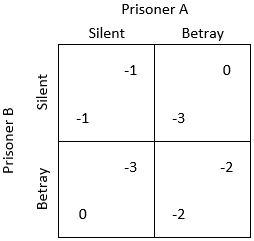Prisoner's dilemma facts for kids
The Prisoner's Dilemma is a famous idea in game theory. It helps us understand why two people might not work together, even when it would be best for both of them. It shows how tricky decisions can be when you don't know what the other person will do.
How the Game Works
The Setup
Imagine two people are suspected of doing something wrong. The police question them in separate rooms. They cannot talk to each other. Each person has two choices:
- Stay Silent: Don't say anything about the other person.
- Blame the Other: Tell the police that the other person is responsible.
Here are the possible outcomes:
- If both stay silent: They both get a short sentence, like 6 months in jail. This is the best outcome for them as a team.
- If one blames and the other stays silent: The person who blames goes free! The one who stayed silent gets a very long sentence, like 10 years.
- If both blame each other: They both get a medium sentence, like 2 years in jail.
No matter what, these two people will not see each other again after this.
The Best Choice for One Person
If you were one of the people in this situation, and you only cared about yourself, what would you do? Let's think about it:
- What if the other person stays silent?
* If you stay silent too, you get 6 months. * If you blame them, you go free! * So, if they stay silent, it's better for you to blame them.
- What if the other person blames you?
* If you stay silent, you get 10 years. * If you blame them too, you get 2 years. * So, if they blame you, it's better for you to blame them.
No matter what the other person does, blaming them always gives you a shorter sentence. This is called a "dominant strategy." It means it's always the best choice for you, even if it leads to a worse outcome for both of you together.
Real-World Examples
The Prisoner's Dilemma helps explain many real-life situations. For example, it can show why countries might struggle to agree on things like climate change. Each country might want to do what's best for itself, even if working together would help everyone more in the long run. It was even studied during the Cold War to understand choices made by countries like the United States and the Soviet Union.
See also
 In Spanish: Dilema del prisionero para niños
In Spanish: Dilema del prisionero para niños


